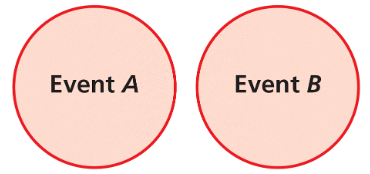Probability: mutually exclusive events
Mutually exclusive events are called nonempty events which can be defined on the same sample space with each event while excluding the occurrence of the other.In other words, these events share no common elements.
Mutually Exclusive Events


There are several ways to express the concept of mutually exclusive, For instance, f you know that either one of the events has occurred, then the other event is excluded or cannot have occurred in the sample space.If you are looking at the lists of the elements making up each event, none of the elements listed for either event will appear on the other event’s list. The equation says, “the intersection of the two events has a probability of zero,” meaning “the intersection is an empty or null set” or “there is no intersection” : P (A ∩ B ) = φ
Mutually exclusive events relate the relationship between the sets of elements that satisfy the events. Mutually exclusive is not a probability concept by definition; it expresses the concept using a probability statement.
If we know that two events are mutually exclusive, then by applying P (A and B) = 0 to the addition rule for probabilities, it follows that P (A or B) = P(A) + P (B) – P (A and B) can be written as P (A or B) = P (A) + P (B).In other words, when A and B are two combined exclusive aspects defined in a sample space S, “the probability of A or B = probability of A + probability of B.”
This algebraic identity is known as the special addition rule:
P (A or B) = P (A) + P (B)
This formula can be expanded to consider more than two mutually exclusive events which can be explained algebraically as:
P (A or B or C or . . . or Z) = P (A) + P (B) + P (C) + …+ P (Z)
This equation is often convenient for calculating probabilities, but it does not help us understand the relationship between the events A and B.It is the definition that tells us how we should think about mutually exclusive events.
For example, when a group of students donate blood at the donation centre, then the events “type O and “type A” blood is donated are mutually exclusive events because one person can only have one blood type.